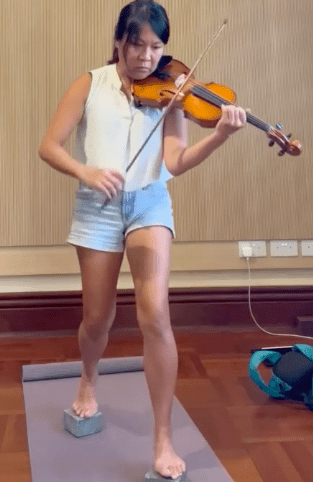From what I’m hearing, it seems like some people think that I do rehabilitation work, or at least that a part of my work is rehabilitative, sort of like therapy combined with learning how to play the violin. I can see how that can be misconstrued, based on my Instagram posts on movement. But really what I aim to do is simply to teach violin. Though arguably, how one defines that and what that entails can vary wildly – but that’s for another post. For simplicity’s sake, let’s just leave it at that. I teach violin. (But if they feel better in their body from playing, that’s even better!)
Making music is multi-faceted. There’s technique, musicianship (the how-to of that in and of itself is multi-layered), note/score-reading, analysis, theory, development in listening and growth of musical instincts, etc, etc… On Instagram, I share mostly the technique-explored-in-movement facet of my work because I believe this lens through which I explore violin technique is quite different from conventional methods. They are also the easiest to condense into 20-second videos on Instagram. But this is by no means the only aspect of music-making that I work on with students. In fact, depending on the person’s need and all kinds of factors, there could be weeks where we might only spend time on putting bow to string to make music.
But perhaps it’s a good time to clarify: what is all the movement about anyway? At this point I’d say this exploration with violin movement is my way of dismantling any pre-conceived notion of what violin technique is, and an attempt to rebuild a picture of what technique means in terms of the actual mechanics of maneuvering the violin, in dynamic relation with the structure and shape of the body. (I’d say that dismantling, questioning, and trying to break things down to their most elemental and simple before reassembling, might be the crux of how I think about everything.) I see it as working on violin technique from the ground up. Trying to view it through all possible, relevant lenses.
Also, in the last few decades, how much advancement have people made in movement science and neuroscience? We move our bodies to play; we use our brains to learn. Both of these fields are directly related to what we do. But classical music education for the most part is pretty stuck in the model from decades, even centuries, ago. If you look closely enough, some of the traditional instructions in terms of how to move are simply incorrect or impossible given how joints actually work. Just because great players have been produced from this system doesn’t mean that there’s nothing wrong with it. I for one believe that there could have been many more great players if things were different. Also, one could give very gifted players the wrong instruction, but they/their body would naturally move the right thing-therein lies the talent. Example: so many instructions are on moving the arms and shoulders, but these two parts have quite limited movement. The very gifted (or someone simply born with flexible scapula) might naturally use their shoulder blades, without even knowing that they’re a contributing factor to their ease in playing, thinking that they’re following instructions to use their arms/shoulders! And then they in turn give instructions to their student to use their arms to do certain things and the student fails. And then that student’s deemed to not betalented/gifted enough. And so the cycle goes.
Having said all this, I know there are great teachers out there using the mostly “traditional” methods with great results – there are students everywhere playing very well, playing with joy. These teachers must all be doing something right. But I’m sure they have their own individual elements to add to these methods. I’m also not dismissing tradition. I am a firm believer that innovation can only be borne out of a thorough understanding and respect of tradition – I’m actually pretty traditional-minded in that sense. But I think it’s only logical to not get stuck stubbornly only looking at what we do from the perspective of decades or centuries ago. (Apply the same scenario to any other field and you’ll see how this sounds a bit ridiculous.) So for me it’s a process of constantly examining and re-examining.

